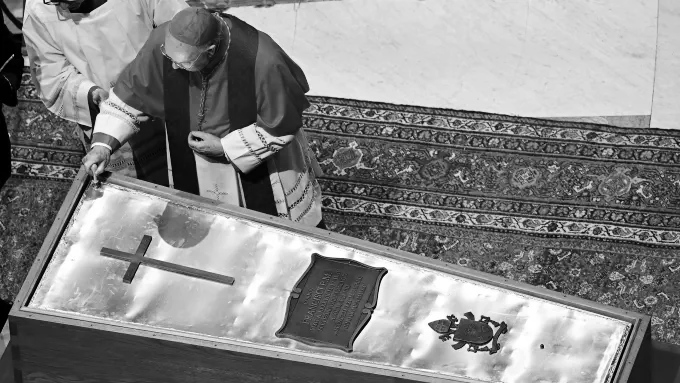Pope Francis’ wooden coffin was sealed on Friday night in a private ceremony, marking the conclusion of three days during which his body lay in state at the Vatican. Approximately 250,000 individuals visited St. Peter’s Basilica to pay their respects to Francis, notable as the first pope from Latin America and from the Jesuit order.
The liturgical rite for sealing the coffin was conducted by Cardinal Camerlengo Kevin Farrell, the acting head of the church responsible for managing funeral arrangements. Farrell, originally from Dublin and now a naturalized American citizen, previously served as the Bishop of Dallas, Texas. Joining him were other church officials, including a Venezuelan archbishop, a Brazilian prelate, and the late pope’s secretaries. Notably, Cardinal Roger Mahony, the retired archbishop of Los Angeles, who faced allegations regarding the mishandling of sexual abuse cases, also participated in the ceremony.
Family members of the late pope took part in the rite, which occurred behind closed doors and included brief songs, spoken prayers, and a period of silent reflection. As part of the ceremony, Farrell placed a white silk veil over the pope’s face and sprinkled holy water on the body. In observance of tradition, he included several items in the coffin before sealing it, such as the pope’s pallium—a long white robe he donned—coins minted during his papacy, and a document summarizing his achievements.
The rite culminated with a hymn dedicated to Mary. Following the ceremony, the Vatican announced that the Chapter of St. Peter’s would maintain a vigil of prayer at the pontiff’s body through the night, leading into preparations for the Holy Mass scheduled for today, Saturday morning.
Pope Francis is being laid to rest with simplified funeral rites, opting for a single wooden coffin instead of the traditional three nested coffins of cypress, lead, and oak. His funeral is taking place outside St. Peter’s Basilica, attracting significant crowds, especially on this fourth day of national mourning in Italy, coinciding with the public holiday of Liberation Day. Many locals and travelers lined up to pay their respects, with thousands joining the queue before the church closed at 7 p.m. local time. Joana Veiga from Porto, Portugal, expressed her gratitude for being able to see the pope, highlighting the peacefulness and calmness of the moment, especially since her sister had missed the opportunity to see him last year.
The funeral is scheduled for Saturday at 10 a.m. local time (4 a.m. ET). This service will initiate the Novendiales tradition, a nine-day mourning period for the deceased pope that involves daily funeral Masses held inside the basilica. Following the funeral, Pope Francis will be interred at the Basilica di Santa Maria Maggiore in Rome. His tomb will maintain a simple style, crafted from marble sourced from Liguria in northern Italy, reflecting his ancestral roots, as his great-grandfather hailed from that region. In accordance with his wishes, the tomb will feature no ornate decorations, displaying only the cross he wore during his tenure as Archbishop of Buenos Aires and the Latin inscription of his papal name, “Franciscus.”
This shift towards simplicity in his funeral rites aligns with Pope Francis’ approach throughout his papacy, emphasizing humility and accessibility. The public’s participation in the mourning and viewing process is a testament to his profound impact, drawing individuals from near and far to pay their respects to a leader who resonated with many across the globe.

